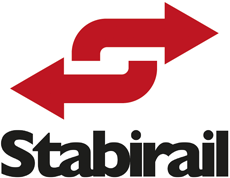Advantages
Stabirail is changing the world of Rail Construction & Engineering. Its revolutionary method for laying slab track leaves more room for design and functionality.
Stabirail’s innovative approach to the slab track construction process has changed the world of rail construction and engineering. We have designed and developed a unique “bottom up” method for milling concrete. With our system concrete slabs are placed first and track is anchored directly to it. This results in a more accurate and faster rail construction process, guaranteeing faster project completion at reduced cost.
Advantages of Slab Track by Stabirail
Stabirail’s slab track construction method offers many advantages compared to other types of rail construction.
- Fast working method: This new technology has proven to be the most efficient solution
- 2mm accuracy: The Stabirail system is operated by a 3D system, allowing for the highest possible accuracy when placing tracks and slabs
- Reduced vibration to the tunnel construction and buildings above: Vibrations caused by passing trains do not pass to the adjacent structures with slab track constructed by Stabirail
- Shallow construction height of the tunnel: Slab track systems require less construction height than their ballasted counterparts. This is advantageous in tunnels where headroom is limited
- Reduced dead load: The reduced construction height means reduced dead load
- Higher speed operation: Higher running speeds are achievable due to a greater degree of stability of the track bed
- Very low maintenance requirements: There are numerous examples of slab track installations where little or no maintenance has been carried out for over the last 25 years, cutting out one of the biggest expenses associated with traditional track
- Long design life: A concrete slab track is constructed with a design life of at least 60 years and does not require much maintenance
- Low whole-life cost: Slab track systems have proven their whole-life cost is lower than that of traditional ballasted track
Efficiency(*)
| Concrete milling machine At max. 10 mm to be milled At max. 20 mm to be milled |
200m / 8h – 600m / 24h 135m / 8h – 400m / 24h |
| Drilling train | 150m / 8h – 450m / 24h |
| Anchoring train | 300m / 8h – 1200m / 24h |
(*) based on limestone concrete
Railway track construction
Stabirail’s unique slab track construction method offers multiple advantages for railway track construction. The biggest benefits of our slab track construction system are its speed and accuracy. Our method is faster than most others, meaning railway track construction projects are completed quicker and at lower cost.
Our machines are operated by a state-of-the-art 3D system, allowing for up to 2mm accuracy. Track constructed onto Stabirail slab is very stable and does not deform over time. Additionally, slab track can go many years with little to no maintenance, meaning our slabs will be good for years to come.
Slab track railroad construction over bridges
Longitudinal movement is one of the most commonly encountered problems when laying slab track on bridges. In traditional “top down” slab track construction methods the rails are put in place first and concrete is poured over, increasing the total weight of a structure. Bridges often start to sag, causing longitudinal movement of the train rails with it.
To counteract this phenomenon, Stabirail uses a “bottom up” approach. Concrete is poured before the rails are anchored, eliminating longitudinal track shifts.
Slab track railway construction in tunnels
Because the underground in tunnels is usually stiff and stable, a tunnel is the perfect location for slab track railroad construction. Stabirail’s technology can be used in all types of tunnel, from metro tunnels to high speed railway passages. Using Stabirail’s new and improved “top down” railroad construction method track can be assembled directly on the concrete bed, thus reducing dead load in small spaces.
High speed rail construction
A common problem with ballasted high-speed rail construction is damage from flying ballast. Flying ballast is a phenomenon that occurs at speeds above 250km/h, a velocity easily reachable by high speed trains. The aerodynamic force induced by a passing train displaces ballast, potentially damaging the track and its surroundings.
Our slab track method for high speed rail construction completely negates any threat from flying ballast. In addition, slab track offers superior stability and barely any track deformation.
Work with Stabirail’s slab track construction process
Rail construction has never been more efficient with Stabirail’s slab track construction system. Our unique method for placing tracks and slabs reduces dead load and requires less construction height than traditional methods. Concrete slabs have an exceptionally long design life and require little to no maintenance.
Interested in working with us? Our specialized technology offers many advantages is available for rent and purchase. No matter the size or complexity of your project, Stabirail has a tailored solution. Our experienced professionals can be hired for comprehensive instruction in the use of our slab track laying technology and are happy to help with any questions you may have about its advantages.
For the most reliable slab track construction technology, look no further than Stabirail. With its use in high-speed rail construction and railway tunnels, our technology has proven to be the most efficient slab tracking solution.
Contact us to learn more about our groundbreaking slab track construction system.
